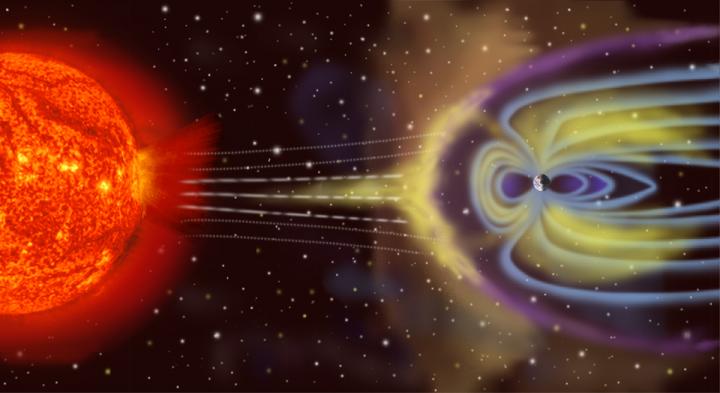European researchers develop a new technique to forecast geomagnetic storms

This is an artist's depiction of solar wind particles interacting with Earth's magnetosphere. Sizes are not to scale. Credit: NASA via Wikicommons
The Earth's magnetic field extends from pole to pole and is strongly affected by solar wind from the sun. This “wind” is a stream of charged particles constantly ejected from the sun's surface. Occasional sudden flashes of brightness known as solar flares release even more particles into the wind. Sometimes, the flares are followed by coronal mass ejections that send plasma into space.
The resulting flux of charged particles travels millions of miles from the sun to the Earth. When they arrive here, the particles wreak havoc on the Earth's magnetic field. The result can be beautiful but also destructive: auroras and geomagnetic storms. The storms are serious and interfere with a number of important technologies, including GPS signaling and satellite communications. They can also cause damage to surface electrical grids. Solar activity appears random, making it difficult for us to predict these storms.
In the journal Chaos, from AIP Publishing, a group of investigators from Europe, led by Reik Donner at Potsdam Institute for Climate Impact Research in Germany, reports a new method for analyzing magnetic field data that might provide better short-term forecasting of geomagnetic storms.
This new method relies on a technique developed for systems in a state far from equilibrium. Earth's magnetic field fits this paradigm because the field is driven far away from equilibrium by the solar wind. Systems that are far from equilibrium often undergo abrupt changes, such as the sudden transition from a quiescent state to a storm.
The investigators used hourly values of the Disturbance storm-time, or Dst, index. Dst values give the average deviation of the horizontal component of the Earth's magnetic field from its normal value. This deviation occurs when a large burst of charged particles arrives from the sun and weakens the field generated by the Earth.
The Dst values form a single stream of numbers known as a time series. The time series data can then be recast into a 2D or 3D image by plotting one data point against another at a fixed amount of time into the future for forecasting.
Here, the authors created a diagram known as a recurrence plot from the reconstructed data. The recurrence plot is an array of dots typically distributed nonuniformly across the graph. The authors used their data to look at a pair of geomagnetic storms that occurred in 2001 from large solar flares a couple of days prior to the storm.
They used a method known as recurrence quantification analysis to show that long diagonal lines in these recurrence plots indicate more predictable geomagnetic behavior. The method reported here is particularly well-suited to distinguish between different types of geomagnetic field fluctuations. The technique allows researchers to characterize these differences with an accuracy not previously achieved.
###
The article, “Temporal organization of magnetospheric fluctuations unveiled by recurrence patterns in the Dst index,” is authored by Reik V. Conner, Veronika Stolbova, Georgios Balasis, Jonathan F. Donges, Marina Georgious, Stelios M. Potirakis and Jurgen Kurths. The article appeared in Chaos Aug. 28, 2018, (DOI: 10.1063/1.5024792) and can be accessed at https:/
ABOUT THE JOURNAL
Chaos is devoted to increasing the understanding of nonlinear phenomena in all disciplines and describing their manifestations in a manner comprehensible to researchers from a broad spectrum of disciplines. See http://chaos.
Media Contact
More Information:
http://dx.doi.org/10.1063/1.5024792All latest news from the category: Physics and Astronomy
This area deals with the fundamental laws and building blocks of nature and how they interact, the properties and the behavior of matter, and research into space and time and their structures.
innovations-report provides in-depth reports and articles on subjects such as astrophysics, laser technologies, nuclear, quantum, particle and solid-state physics, nanotechnologies, planetary research and findings (Mars, Venus) and developments related to the Hubble Telescope.
Newest articles

High-energy-density aqueous battery based on halogen multi-electron transfer
Traditional non-aqueous lithium-ion batteries have a high energy density, but their safety is compromised due to the flammable organic electrolytes they utilize. Aqueous batteries use water as the solvent for…

First-ever combined heart pump and pig kidney transplant
…gives new hope to patient with terminal illness. Surgeons at NYU Langone Health performed the first-ever combined mechanical heart pump and gene-edited pig kidney transplant surgery in a 54-year-old woman…

Biophysics: Testing how well biomarkers work
LMU researchers have developed a method to determine how reliably target proteins can be labeled using super-resolution fluorescence microscopy. Modern microscopy techniques make it possible to examine the inner workings…





















